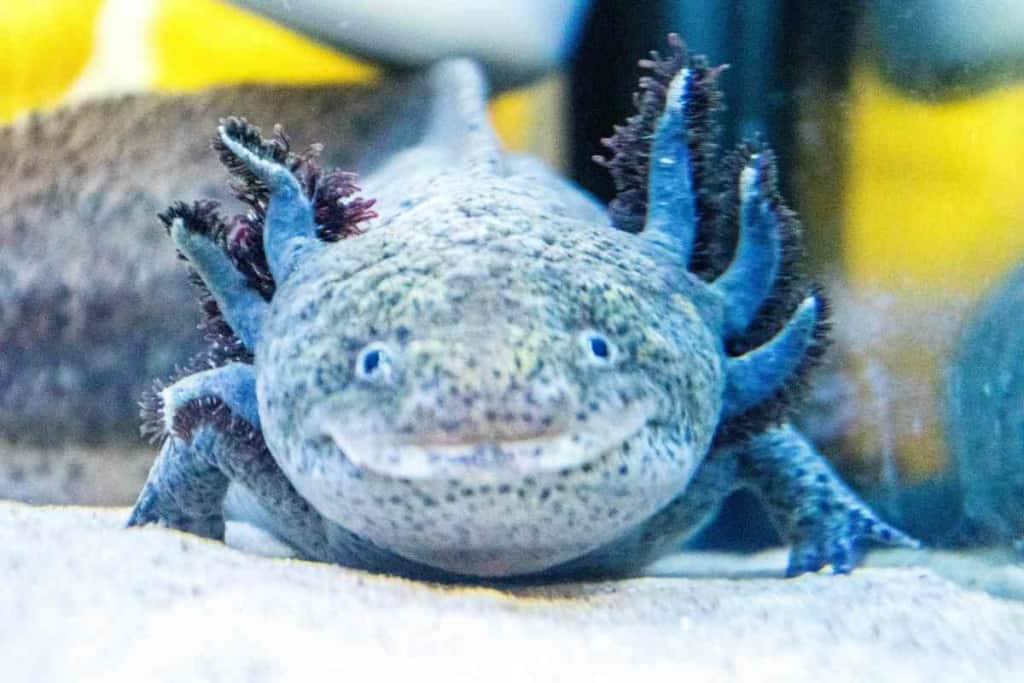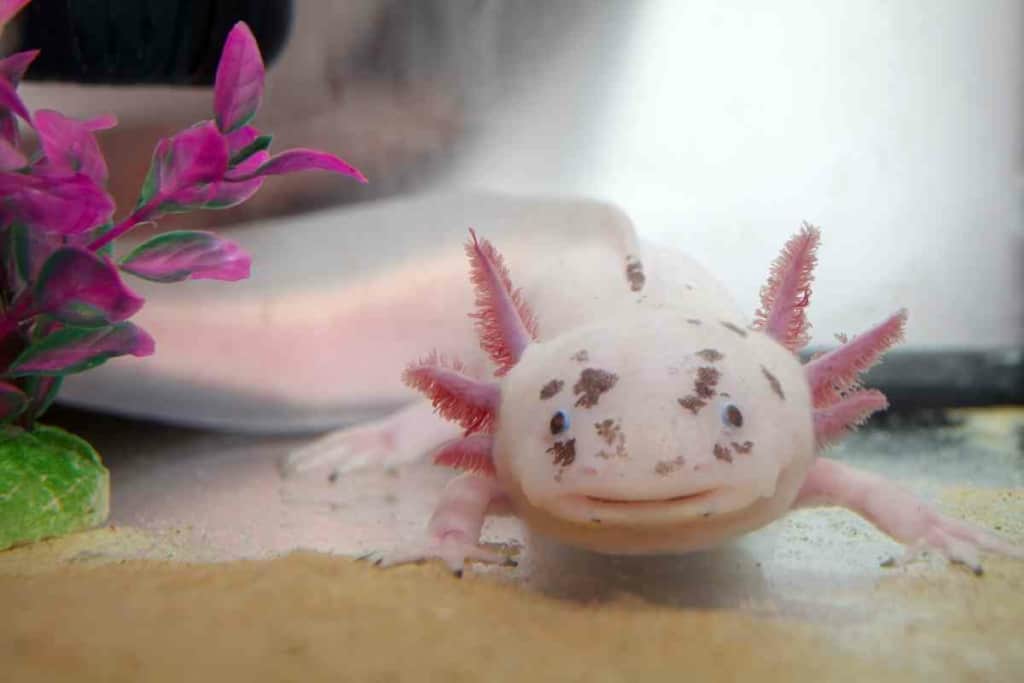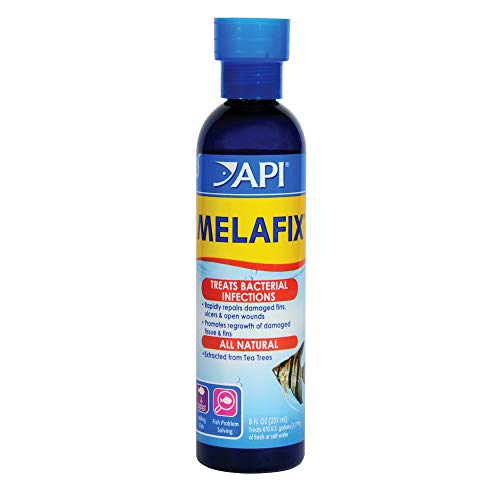Is Melafix Safe For Axolotls? Know Before You Dose!
Like other pets, axolotls get sick, and they need medication to treat them. Melafix is a useful medicine for such purposes, but is Melafix safe for axolotls?

Is Melafix Safe For Axolotls?
Yes, Melafix is safe for axolotls. However, there are a few things to consider. You need to know whether your axolotl is infected. Also, don’t administer Melafix without a veterinary prescription. You also need to know if your axolotl needs powdered Melafix or liquid Melafix.
As axolotl owners, we have dealt with many sick axolotls over the years. Like any other medication, Melafix can only work if it is administered the right way and in the right quantity.
The slightest mistake can cause your efforts to backfire, which can put your little amphibian in danger.
What Is Melafix?
Have you heard of Melafix? It’s a common product used in aquariums for fish diseases and infections. But did you know it can also be used for axolotls?
Melafix is made from all-natural tea tree oil, which has antifungal and antibacterial properties. It’s been known to help treat superficial wounds, fin and tail rot, eye cloudiness, and more.
However, Melafix should not be used as the sole treatment for serious ailments or infections. It’s important to consult with a veterinarian before using Melafix or any medication on your axolotl.
As with any medication, Melafix should also be used carefully according to the instructions on the label. In short, Melafix can be a useful tool in treating common health issues in axolotls, but it should always be used with caution and under professional guidance.

Things to Consider Before Trying Melafix on Your Axolotl
Before reaching for that bottle of Melafix to cure your axolotl’s ailments, it’s important to consider a few things.
First, consider whether or not your axolotl actually needs medication at all. In some cases, the issue may clear up on its own or with some simple changes to their habitat.
If your axolotl requires medication, it’s best to consult a veterinary professional before administering any treatment.
They will be able to prescribe the appropriate medication and advise on the proper dosage. Keep in mind that Melafix is generally used for minor issues such as superficial wounds and bacterial infections, and more serious health problems may require a veterinary prescription.
In addition, be sure to carefully follow the instructions on the packaging, particularly when it comes to quantity; using too much can harm the animal, while using too little may not be effective.
Finally, remember that Melafix is available in both powdered and liquid form; although they have similar effects, they must be administered differently, so be sure you have the correct type for your axolotl’s needs.
By keeping these factors in mind, you can ensure the safety and well-being of your pet.
Signs of Wounds and Infections in Axolotls

As peaceful as they may appear, axolotls are still wild animals and can sometimes get into fights with other axolotls or tank mates.
While not always apparent, wounds can be spotted through examination of the axolotl’s body. Redness and swelling in the area of a wound, along with continued bleeding even after the initial injury, are all signs that the wound may require medical attention.
Likewise, infections can also occur on wounds or elsewhere on the axolotl’s body.
These can manifest as discoloration or darkening of the skin, along with an extreme sensitivity to touch in the affected area.
If you suspect that your axolotl may have a wound or infection, it is best to seek veterinary care from an exotics specialist as soon as possible to prevent any further harm to your pet.
Causes of Infections in Axolotls
One major reason for axolotl infections is a dirty tank. The buildup of waste and uneaten food can lead to bacteria growth, resulting in skin and fin infections.
Inadequate filtration systems can also contribute to these issues. Another cause of infections is injury or abrasions from decorations or other tank mates. These open wounds provide an entry point for infection-causing bacteria.
Along the same lines, improper tank setup or overcrowding can lead to physical damage and infections. Finally, poor water quality, specifically high levels of ammonia and nitrates, can also result in infections for axolotls.
It’s important to regularly clean and monitor the water conditions in order to keep your pet healthy and prevent infections.
As always, if you suspect your axolotl has an infection, it’s best to consult a veterinarian familiar with amphibians.

Ways to Prevent Infections in Axolotls
When it comes to keeping your axolotls happy and healthy, one big concern is infections. Luckily, you can take some easy steps to prevent these issues.
First and foremost, make sure you are using clean and filtered water for your tank. This will help avoid introducing bacteria into their habitat.
Second, regularly clean the tank and filter the sponge to remove debris and waste that could lead to infection. Third, watch for any cuts or scratches on your axolotl’s skin and treat promptly with an antibiotic cream or medication recommended by your veterinarian.
Fourth, provide a well-balanced diet to support their immune system. And finally, thoroughly wash your hands before handling them and other equipment in order to reduce the spread of bacteria. Following these precautions can decrease the likelihood of infections in your axolotls.
Alternative to Melafix
When it comes to treating infections in axolotls, silver sulfadiazine cream, or SSD, can be a great alternative to the popular fish medication Melafix.
While Melafix may have some effectiveness for minor issues, SSD has been found to have much better results for serious infections, particularly when used alongside antibiotics.
However, it’s important to note that SSD should never be used as a preventative measure and should only be applied to affected areas as directed by a vet.
Unlike Melafix, SSD is also not safe for invertebrates, so removing any snails or shrimp from the tank before treatment is important.
Overall, SSD can be a great option for severe infections in axolotls but always consult a veterinarian before use.
Downsides of Melafix Overdose
When it comes to treating injuries or infections in our pet axolotls, Melafix seems like a quick and easy solution. However, Melafix is not specifically designed for use in amphibians, and giving too much can actually do more harm than good.
One common symptom of Melafix overdose in axolotls is severe loss of appetite leading to weight loss and potentially even death. In addition, Melafix can also cause gill damage and even organ failure in high doses.
For these reasons, it’s important to always carefully follow the recommended dosage instructions when using Melafix or consider alternative treatments specifically designed for amphibians. Taking these precautions can help ensure the health and safety of our beloved axolotls.
Key Takeaways
- Make sure your axolotl actually needs Melafix before you administer it.
- A major symptom of a Melafix overdose is a lack of appetite, so if you’ve been administering Melafix and your axolotl has stopped eating, you need to cut back on the dosage.
- SSD is a good alternative to Melafix, but it comes with side effects, so be careful when using it to treat your axolotl.
- Consult a veterinarian to ensure that your axolotl needs Melafix, and if so, the recommended dosage.

